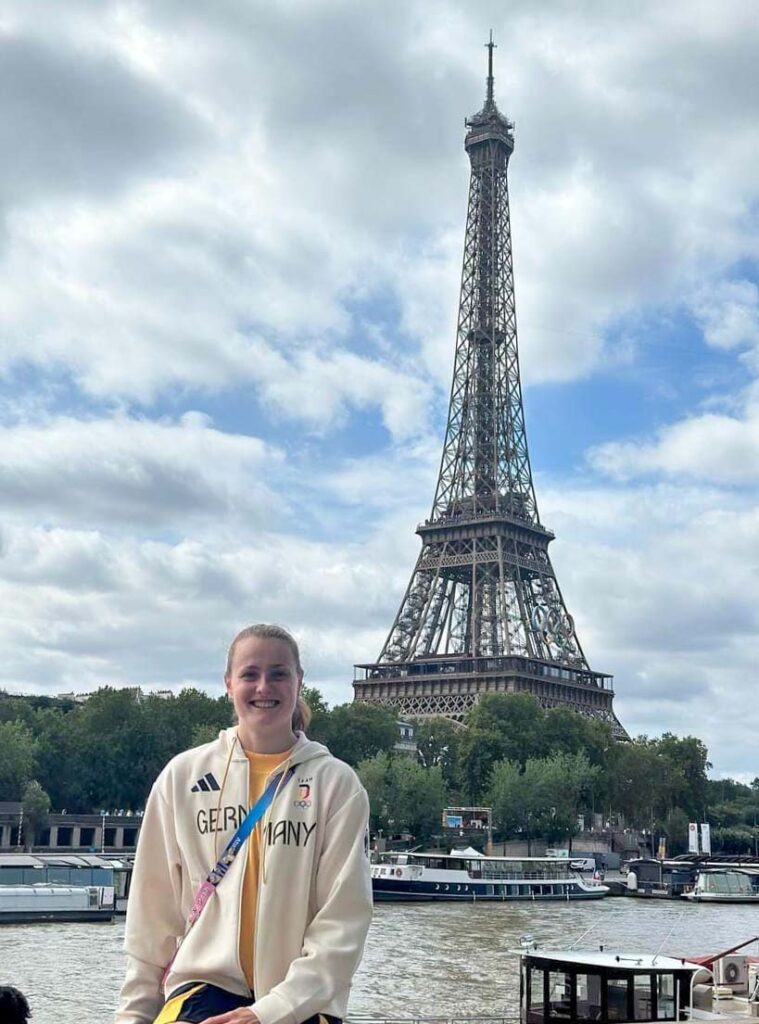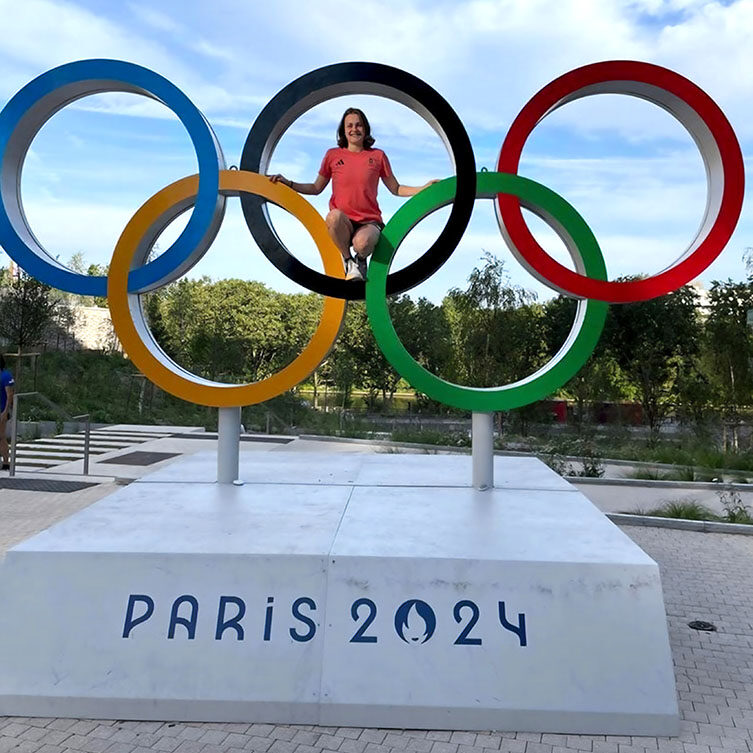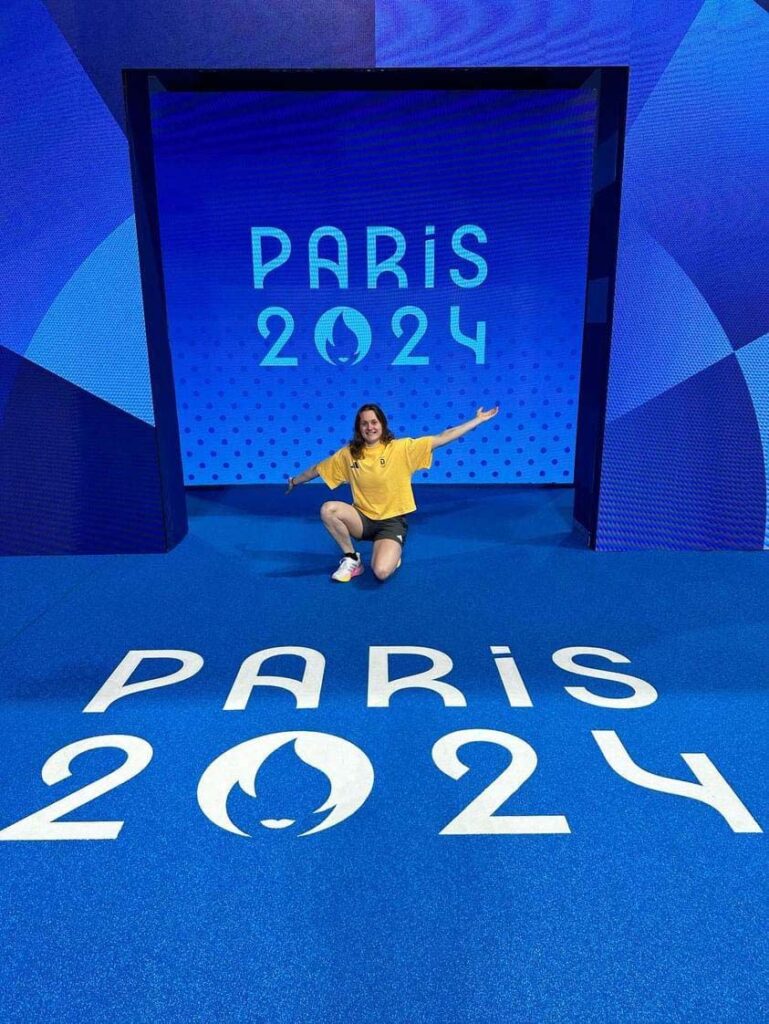In addition to her role as a student at MLU, Laura Riedemann is also an accomplished competitive swimmer. In the summer of 2024, she competed in the Olympic Games for the second time. In our conversation, she shares insights into how she manages to balance the demands of elite sports and her studies.
Laura Riedemann is 26 and studying to become a secondary school teacher for German, Civics, and P. E. Her swimming journey began in the most classic way: earning her first swimming badge, the “Seepferdchen”, a basic certification for beginner swimmers in Germany. She enjoyed it so much that, according to her, she simply “kept going.” Since primary school age, Laura regularly competes in swimming meets. In smaller competitions at the regional and national levels, she swims “a wide range of events.”
The second Olympic nomination
The nomination for the 2024 Olympic Games in Paris was the second for the woman from Halle. She competed in her first Olympic Games in 2021 in Tokyo. In our conversation, the swimmer told us how the process of an Olympic nomination works: “About six to nine months in advance, we athletes receive qualifying times that we need to swim. Then, there is usually a set period during which we must achieve the required time, within specific competitions.”
The swimmers choose in which events they want to participate, as too many races can negatively affect the performance curve, which should be kept as consistently high as possible. Competition type and swimming venue are also crucial criteria when choosing events, as every athlete has certain venues where they feel more comfortable or less. Athletes then prepare for their chosen races and aim to meet the required qualifying times. Should a participant fail to achieve the specified time, Laura explains that swimming offers relay events where the fastest swimmers in each stroke or discipline are selected to secure qualification for the Olympics. For instance, Laura Riedemann was nominated as the fastest backstroke swimmer for the relay team at the 2024 Olympic Games.
| Performance Curve The performance curve, also known as the achievement curve, is an extremely important concept in sports. It is a graphical representation of an athlete’s performance over a specific period, showing how the performance has developed over time and whether the athlete has improved or deteriorated. |
Reflecting on her nomination, the swimmer describes her feelings as a great relief, especially since her training had not gone well in recent years.
Balancing university and elite sports — Here’s the secret!
Laura describes her days as starting early and stretching well into the evening. That already started during her time at the sports school, where lessons started at 7 am and the day ended with training at 7 pm. Therefore, the swimmer is well familiar with highly structured and busy days.
Typically, the Halle-based athlete has ten training sessions per week, usually held twice a day, except for Wednesday afternoons, which are designated as rest periods. Instead, a training session takes place on Saturday mornings. Each session lasts an average of two to three hours, with two hours spent swimming and an additional hour dedicated to specific athletic training: stability training on Mondays, flexibility exercises on Thursdays, and strength training on Fridays. Stability training focuses on challenging and improving athletes’ core stability. These exercises are typically static strength workouts where movements are performed very slowly, and positions are held for as long as possible.

Between training sessions, the 26-year-old tries to fit in her university lectures and seminars. She explains that her university workload was less intense as the Olympics approached. At that time, she limited herself to just two or three seminars, as she found it difficult to mentally focus on training otherwise, which remains her top priority.
Maintaining a balanced diet is, of course, crucial for a professional athlete. “You eat whenever you can fit it in. You prepare a lot in advance, bringing meals with you so you’re not forced to grab something ‘unhealthy’ on the go. That way, you know exactly what you’re eating and have it ready at hand.” In addition, Laura emphasizes the encouragement she receives from her university and professors, noting that they are generally very understanding of her commitments as a professional athlete. Now in her 15th semester, she mentions that she deliberately takes her time with her studies.
The Road to Paris
In principle, Laura’s training routines continued in the same manner, even after her Olympic nomination. “Usually, the qualification is so demanding that you have to prepare both physically and mentally in training as you would for the peak of the Olympic Games.” Even before the qualification, training camps take place to focus entirely on swimming.
Before the German relay team flew to Paris, they met for just under a week in Berlin. Most of the athletes already knew each other, but during this preparation phase, they could fine-tune important details. “Especially in the relay, I rely on three other swimmers, and we use this time to make sure that during the handovers between athletes, the exchange times are as short as possible, so we can practice them together.”
Her coach was still with her in Berlin at that time. However, at the Olympic Games, the DOSB (German Olympic Sports Confederation) has a set number of coaches, physiotherapists, doctors, etc., who can travel with the athletes, so not every personal coach can be there. For the 2024 games in France, Laura’s coach had to cheer from home. Laura found this farewell difficult because her coach had been present at her first Olympic appearance in Tokyo in 2021. She describes her role as reassuring and grounding, calling her coach a “familiar environment and place of trust and safety.”
At the airport, the German team was warmly welcomed with typical French snacks like croissants. They also met athletes from other nations. And here’s an interesting fact — all athletes from a nation have a “clothing guide” that dictates what they should wear for specific occasions, such as arrival, in the Olympic Village, or during the award ceremony. Laura further explains: “It’s really cool when the team walks through the airport looking uniform, and other nations can see which country you’re representing.”

Shuttle buses took them to the Olympic Village. Laura found this period very stressful, as not only did they have to orient themselves on the grounds, but they also had to continue their training alongside routines like registration and settling in. The buses were the typical mode of transport to the swimming hall. There were designated bus stations for each sport and its venues. Training in the competition hall continued as planned. “Depending on how much time we had in between, we could explore the village. For example, in Paris, we had our own souvenir shop, as well as cafés and bakeries.”
Fun fact: The beds in the Olympic Village were made of cardboard, with mattresses made from recycled plastic, which wasn’t necessarily comfortable for many athletes. While you could flip them, as Laura says, “whether you sleep on a hard or very hard mattress, it doesn’t make much difference.” She continues: “I sleep either way. It’s not super comfortable, but you get used to it.” For example, Germany’s fastest 100-meter sprinter and European champion, Gina Lückenkemper, always brings her own mattress topper to competitions.

On the day of the competition
The day of the relay swimming competition was a mix of anticipation and calm. To prepare for the late-day event, athletes typically begin with a land warm-up followed by a swim. Laura, reflecting on the pre-competition routine, shared, “I usually have a half-hour to relax, listen to music, and then gear up in my competition suit. After that, it’s off to the call room with the team.”
In the call room, a final check of accreditation and equipment, like swim caps, ensures everything is in order.

A unique feature of the Paris Olympic swimming venue was the spectator stands, which extended almost to the pool’s edge. This unusual proximity created an electric atmosphere, drawing spectators closer to the action.
Laura was fortunate to have the support of German fans, including her father. “I knew where he was sitting, but I didn’t want to look before the race. As I swam the first leg of the 4 × 100 metre medley relay, I glanced over and saw him. It was a truly special moment, especially with the crowd’s energy.“
The deafening cheers from the crowd were a testament to the passionate German fan base. “We’re not accustomed to such a large audience, so it was an incredible experience for all of us,” Laura remarked.
| Lagenschwimmen ist ein Schwimmwettkampf mit vier wechselnden Schwimmstilen. Es müssen folgende Schwimmarten verwendet werden: Schmetterlingsschwimmen, Rückenschwimmen, Brustschwimmen und Freistilschwimmen. |
Despite the team’s ninth-place finish, Laura was proud of their performance, especially considering recent challenges and her age in the sport. „We gave it our all. It’s disappointing to miss the final by one place, but we can be proud of our effort.“
“What did you take away from Paris and the 2024 Olympic Games?”
The feeling on the starting block was indescribable for the 26-year-old student. “Actually, I didn’t even need a vacation afterward — I could have just kept swimming. My motivation was that high,” says Laura. She felt immense pride in being a part of the whole experience in the Olympic Village and the German team. “The friendly and warm atmosphere between everyone. There were around 400 to 500 people in our team, and you don’t know everyone, but everyone experiences this warm atmosphere on the street as well. This is something I sometimes wish our whole society could be like.“
Athletic Outlook and Private Future
Athletically, the swimmer from Halle wants to see how things progress year by year, as she considers herself „one of the older athletes in swimming.“ Most swimmers in Germany are born in 2001 or later, she explains, so it’s rare to see a birth year starting with 19.
This semester, her studies are her main focus, as she is currently writing her thesis and wants to successfully finish her degree.
Privately, the two-time Olympian is happy with her fiancé, whom she will marry next year. “Yes, in 10 years, I see myself with two children, a little dog, and as a teacher at a school in Halle, together with my fiancé, who is also a teacher,” she concludes our conversation with Olympian Laura Riedemann.
Text: Elisa Marie Elkner
Translation: Sophie Buchholz
